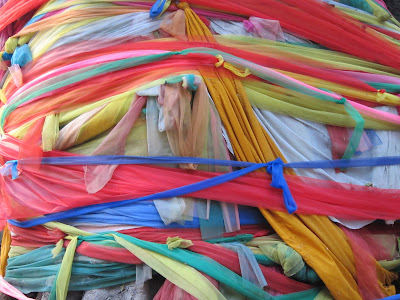I thought I would share with you the story and significance
of the bodhi leaf. It is a common
element in Thai spiritual artwork, and I’ve been rather drawn to its simple
charm since I first encountered it.

In Thai, it is
called “bai bo” (bai = leaf; bo = the abbreviated word for
bodhi). The word “bodhi” is both a
Sanskrit (Ancient Indian) and Pali (Ancient Thai) word that translates as
“enlightenment” or “wisdom.” Today, the
tree’s scientific name is Ficus religiosa. It is revered because it is said to be the type of tree under
which Siddhartha Gautama, the spiritual teacher and founder of Buddhism, was
said to have been meditating when he attained enlightenment, after which he was
called the “Buddha,” a Sanskrit word meaning “the awakened one.” Thus, the tree became sacred to Buddhists,
and its leaf a symbol of peace and happiness.


The particular bodhi tree under which the Buddha meditated
grew at Bodh Gaya in northern India. Siddhartha Guatama lived some 500 years
before Christ, so the original bodhi tree died long ago. However, clippings of it were taken and
planted throughout India and Sri Lanka.
The oldest living bodhi that was started as a sapling from the mother
tree grows in Anuradhapura, Sri Lanka, now a sacred pilgrimage site. It was
planted in 288 BC, making it the oldest living human-planted tree in the world
with a known planting date.
 |
| Bodhi tree at Anuradhapura, Sri Lanka |
Many temples throughout the Buddhist world have bodhi trees
accompanying them that are (or are thought to be) descended from the
Anuradhapura one, and their worship is a common Buddhist practice.
 |
| head of Buddha statue cradled in tree at the ruins in Ayutthaya, Thailand |
The banyan tree, or Ficus bengalensis, is a cousin of
the bodhi and is often revered as well.
Although their appearances are quite distinct and I’m not sure how
confusion between the two occurs, I do understand the compulsion to honor the
banyan. With its dangling aerial roots
and twisted expansive trunk, it exudes a sort of magical charm. Thais often venerate it by adorning it with
multi-colored ribbons and incense sticks.



At the market where I shop for Buddha amulets, images of the
Buddha meditating are ubiquitous, but ones in which he is sheltered by the
leaves of the bodhi are rare, and finding them can take persistent
digging. Luckily, I’ve got doggedness
in spades and succeeded in unearthing some I really love. I recently featured these Buddha and bodhi
leaf amulets in several new earthy green necklaces.
 |
For sale at: https://www.etsy.com/listing/151814315/buddha-with-bodhi-leaves-green-thai?ref=shop_home_active















